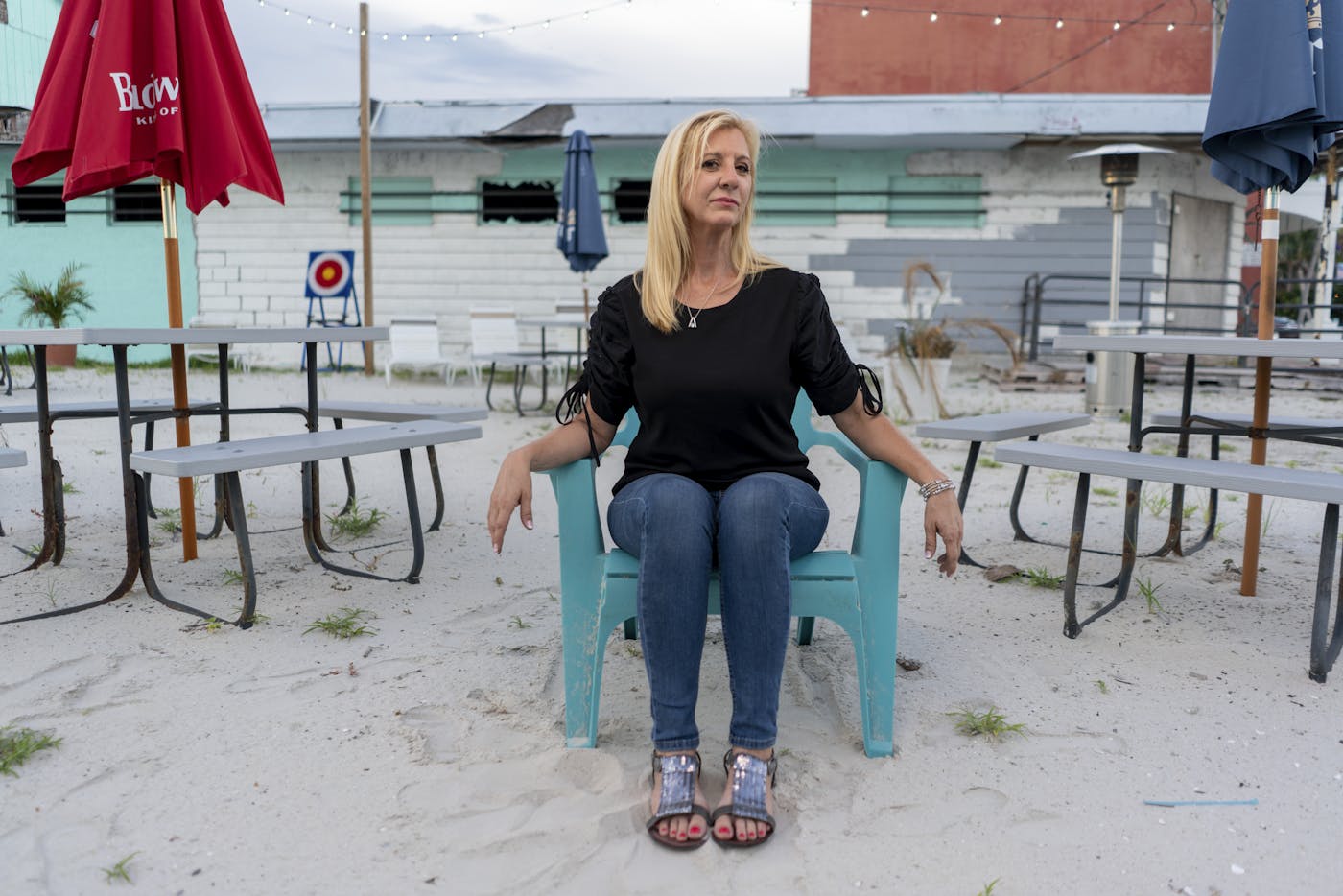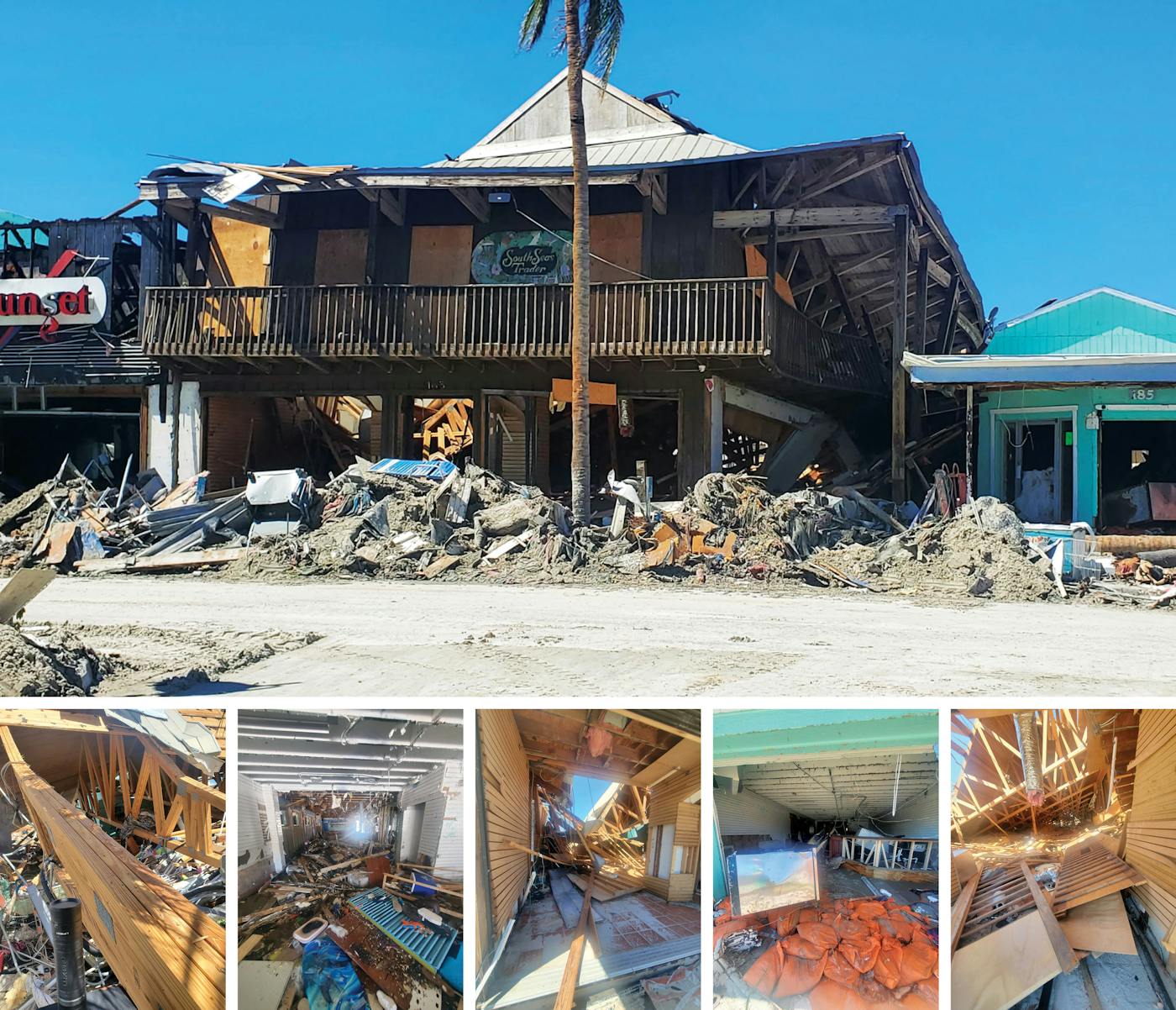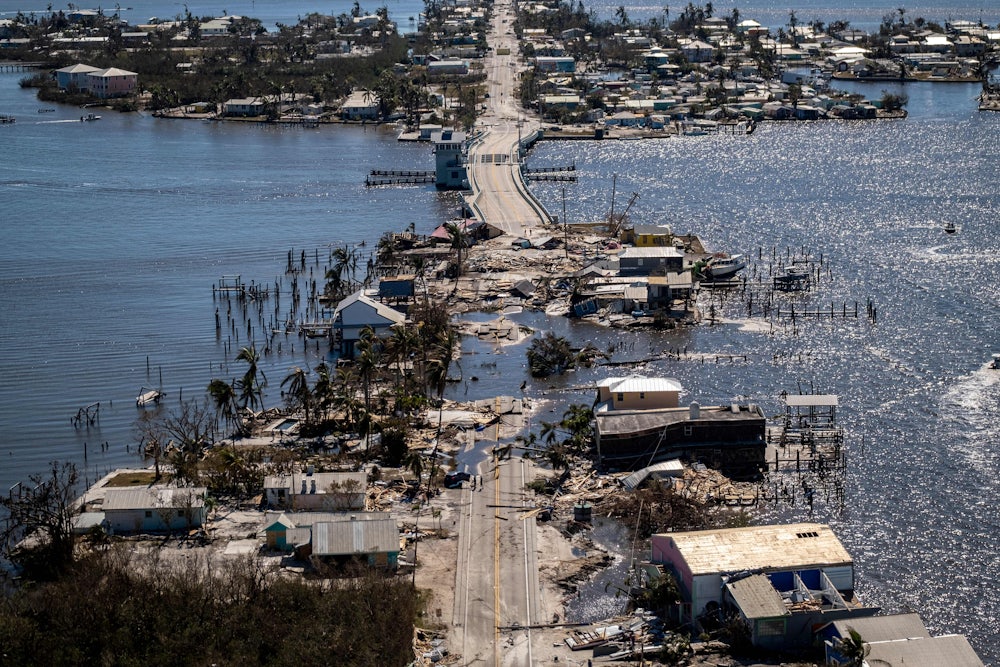Until mid-May, when Suzi Bahan decided she was done fighting with FEMA and getting the runaround from the Fort Myers Beach Town Council, Suzie Q’s Tiki Bar—an alfresco joint a few blocks from the beach offering a bucket of Busch (five bottles on ice) for just $13—was one of the more congenial watering holes in town. “Tiki Bar” was probably a stretch. The makeshift saloon was really just a patch of sand, ringed with cattle fencing, onto which Bahan, the owner, had dragged some outdoor furniture, a plastic outhouse, and two trailers. From one trailer, she operated the business, checking IDs and dispensing beverages and salty wisecracks. The other trailer, just steps away, was her home.
This was never the plan, Bahan told me one night in February, pausing now and then to adjust the stereo (all yacht rock, all the time) and keep her clientele well-lubricated. She was just two weeks from opening a more conventional establishment when Hurricane Ian blew into town, on September 28, 2022.
A lifelong resident, she was inclined to ride out the Category 4 storm. “Floridians are like, ‘Fours are bad, but, like, how bad?’” she explained. Fortunately, her terrified dogs were less sanguine, and she ultimately evacuated, returning a few days later to find that Ian had laid waste to much of Estero Island. “I don’t cry easy,” she recalled. “But the day that I walked over that bridge and I saw what was left of my life, I literally hit my knees. It was life-altering.”
In pursuit of a commercial loan, Bahan had forked over $40,000 for just her first year of property insurance. Coverage was provided by two separate underwriters: the state-run Citizens Property Insurance Corp. for wind damage (private insurers generally decline to offer such policies), and a private, FEMA-backed company for flood.
But as the storm subsided, the haggling began. Citizens paid promptly, Bahan recalled. But her private insurer, after issuing a check, canceled payment before it was deposited. Then it denied the claim entirely, on the logic that honoring its agreement would somehow constitute paying her twice for the same event. (Never mind that both policies put together wouldn’t come close to covering her costs.) Bahan lost a lawsuit in federal court and is appealing.

Bahan’s insurance nightmare was one of many related to me during a visit to southwestern Florida, where residents have endured three major hurricanes—Ian, Helene, and Milton—in as many years. Each tale turns on its own particular outrages and ironies, but common themes aren’t hard to spot: eye-watering rate hikes, dropped policies, shady adjusters, paltry payouts, and claims denied for dubious reasons. State Farm, for instance, closed 46 percent of 2023 claims after issuing no payment whatsoever, and it was hardly an outlier. Meanwhile, even as they were doing everything possible to limit payouts, insurance companies were socking away massive profits, according to a secret state report that became public just a few weeks before my trip. While Florida’s situation is extreme, it represents an early warning sign in a troubled property insurance system that is, as U.S. Senator Sheldon Whitehouse put it in a 2024 committee hearing, “swirling the drain.”
A decidedly unglamorous business that mostly draws attention when it fails, property and casualty insurance, or P&C, has for decades quietly powered the economy and bolstered the American picket-fence dream. “Insurers are the foundational layer for most homeownership,” Abrahm Lustgarten, author of On the Move: The Overheating Earth and the Uprooting of America, told me, “and thus for most American middle-class wealth.”
In recent years, however, the insurance industry has begun to look notably shaky, staggering from one crisis to the next on its way to what some observers say could become a meltdown. As extreme weather events—an apocalyptic laundry list including but not limited to floods, windstorms, hailstorms, wildfires, droughts, mudslides, and heat waves—grow more frequent and intense due to the heedless destabilization of the climate, premiums are rising, payouts are shrinking, and, increasingly, carriers are bailing on markets deemed too risky. Millions of policyholders received nonrenewal notices in recent years, and many are now taking their chances without any protection.
Before too long, they may have no other choice. Some locations are already becoming essentially uninsurable, according to a report by the climate risk nonprofit First Street Foundation—forcing state governments to step in with so-called insurers of last resort, like Florida’s Citizens or California’s FAIR Plan. More than 30 states now have such plans, and most flood insurance is provided through FEMA. But government-backed plans are subject to the same unforgiving scientific principles as their private counterparts. After all, among the fundamentals of the property insurance business is the long-standing premise that, however unpredictable the weather, it adheres to certain probabilities, allowing us to make reasonable guesses about its behavior, and costs, over time. Unfortunately, a heating climate is swiftly upending that logic, as the more frequent occurrence of “100-year floods” amply demonstrates. And risk assessment will only become more difficult as atmospheric “feedback loops” kick into action. (Recent budget cuts to the National Oceanic and Atmospheric Administration and other research programs—even as annual spending on climate-related damage approaches $1 trillion—will presumably exacerbate the problem.)
“I don’t think we’re in imminent risk of the whole system collapsing tomorrow,” said Carolyn Kousky, the acting chief economist at Environmental Defense Fund and founder of the nonprofit Insurance for Good, “but risk is growing dramatically year on year, and we have not done any of the necessary decarbonization to stabilize that increasing risk.” As Whitehouse put it in a recent interview, “There’s no Band-Aid big enough to paper this over if you don’t deal with the fundamental underlying danger.”
In March, Günther Thallinger, who serves on the board of Allianz, one of the world’s largest insurance companies, published a LinkedIn post describing the bleak future that awaits us. “The economic value of entire regions—coastal, arid, wildfire-prone—will begin to vanish from financial ledgers,” Thallinger predicted. “Markets will reprice, rapidly and brutally. This is what a climate-driven market failure looks like.”
Given that banks generally decline to issue mortgages on uninsured property, it’s not hard to imagine the potential economic impact on high-risk regions. Tighter credit means fewer buyers. Faced with a shrinking tax base, municipalities will cut their budgets. Some will privatize utilities and other core functions in a bid to head off bankruptcy. Alarmed by unfilled potholes, ballooning class sizes, and other indications of disarray, wealthier residents will relocate, creating what Lustgarten calls “a spiral of economic decline.”
Or as Whitehouse put it in the hearing, “Climate risk makes things uninsurable. No insurance makes things unmortgageable. No mortgages crashes the property markets. Crashed property markets trash the economy.”
The early stages of such a scenario may already be taking shape in Florida’s storied condo market, where, in the wake of the 2021 collapse of a condominium due to deteriorated structural supports, owners have been hit not only with higher insurance premiums but with new assessments for maintenance and repairs and skyrocketing homeowners’ association fees. Many are now “desperate to sell,” per The Wall Street Journal. “I do think that the Florida insurance system is extremely rickety and insubstantial, barely even able to be properly called an insurance system,” Whitehouse told me. “It’s like a simulacrum of an insurance system. It looks like one until there are claims.”
Of course, governments will inevitably step in. But this, too, has its perils. Per Thallinger, “If multiple high-cost events happen within short time spans—as climate projections expect—then no government can realistically cover the damages without either austerity or collapse.”
The insurance crisis is national in scope, but thanks to the 1945 McCarran-Ferguson Act, which bafflingly exempted the industry from federal oversight, it is mostly being felt on the state level. In California, the recent wildfires have led to a pitched battle over a rate increase. In Colorado, the government is scrambling to mitigate costs by considering subsidies for fortifying roofs against increasingly destructive hailstorms. In Nebraska, premiums have more than doubled in a decade, while in Texas, they rose 22 percent last year alone. And in Idaho, nearly a quarter of insurers have bailed since 2023, and experts are forecasting an average rate hike of 30 percent.
But it’s the Sunshine State where the effects have been most dramatic. In 2010, journalist Paige St. John dubbed Florida’s housing stock “the largest catastrophe risk in the insured world.” Her Pulitzer-winning reporting in the Sarasota Herald-Tribune brought the challenges—and the petty corruptions—that characterize the local market to widespread attention. The series’ impact was likely softened, however, by a run of miraculously placid weather; between 2006 and 2015, the state wasn’t hit by a single hurricane.
Insurers collected premiums nevertheless and should theoretically have banked billions in reserves. But even before Ian, more than a dozen had become insolvent, and major carriers were exiting. With rates rising to four times the national average in some areas, policymakers were eager to identify a culprit—ideally, one that didn’t place too much emphasis on the changing climate. They found it in one of the few professional classes more reviled than insurance executives: lawyers. Carriers were being sued out of business, it was explained, by a network of shady law firms and unscrupulous roofers. The state insurance commissioner at the time, David Altmaier, bolstered the claim with a much-cited study suggesting that Florida had accounted for 8 percent of the nation’s insurance claims in 2019 and 76 percent of lawsuits against insurers.

A good number of those suits carry Mordechai Breier’s signature. “This firm, by definition, would be what was being demonized,” Breier told me when I visited him at the modest North Miami office of the Insurance Litigation Group, where he is managing partner. “When they’re talking about abusive attorneys, they’re talking about me.” Breier is a colorful figure, a spirited, compact Orthodox Jew who wears his side curls tucked behind his ears. “I walk into a courtroom, and the first question is ‘Who’s that wacko?’” he told me. “I tend to make a splash, just my personality.” In some rural backwaters, Jews are a rarity, which is one reason why, as he put it, “I also carry wherever I go, openly and proudly.” Another possible reason: Being smeared as one of the supervillains of Florida’s insurance crisis can have safety implications.
Breier acknowledges that some of his competitors took advantage of the system. “Any process where there could be abuse, you’re gonna have bad actors stepping in and abusing,” he said. “That’s true in any industry.”
The state legislature responded with a bundle of tort reform measures that, among other things, did away with one-way attorneys’ fees. It also made it harder to sue an insurer for acting in “bad faith,” or prioritizing its own financial interest over its obligations to claimants. The new legislation was signed into law on December 16, 2022.
Not everyone applauded the new rules, however. Donald Trump excoriated Governor Ron DeSantis on Truth Social for “delivering the biggest insurance company BAILOUT to Globalist Insurance Companies, IN HISTORY.” Trump was then gearing up to battle “DeSanctimonious” for the Republican presidential nomination and eager to downplay his rival’s apparent triumph, but he had a point. It didn’t help that just the day after the bill passed the state House, Altmaier, the insurance commissioner who’d championed it, tendered his resignation, eventually announcing a new job helping “insurance and insurance-adjacent entities navigate the complex world of regulation and regulatory policy,” per his LinkedIn. (It was a well-timed move. Days after he left the post, Florida’s new “revolving door” standards, which would have forbidden him from lobbying for six years, took effect.)
Meanwhile, as months went by without a decrease in premiums, Floridians began to wonder if they’d been had.
“Were there some problems? Yes,” Kousky of the Environmental Defense Fund said of litigation abuse. “Have some of them been addressed? Yes. Were they addressed too well, in the sense that they’ve actually hurt consumers? Probably.” Said Whitehouse, “If you don’t deal with the underlying cause, it really is deck chairs on the Titanic, and that’s why you get these silly things like the insurance industry trying to blame its predicament on its traditional nemesis, the trial lawyers.”
Doug Quinn is inclined to agree. A lumbering former Marine with a hoarse Jersey accent and a trim blond goatee, Quinn is the founder and executive director of the American Policyholder Association, in which capacity he travels the country organizing homeowners and pressing the case that the industry’s complaints about “insurance fraud” obscure a considerably more vast crime, what he dubs “insurer fraud.” Quinn came to this realization through hard personal experience. In 2012, he lost his house in Toms River, New Jersey, to Superstorm Sandy, then fought an expensive legal battle with his carrier before finally moving back into the rebuilt home—now jacked up 10 feet—after seven long years.
Judging by Quinn’s tendency to cite Noam Chomsky on the subject of regulatory capture, the experience seems to have radicalized him. He created the American Policyholder Association, or APA, in 2018, and ditched his lucrative career as a financial adviser. He now moonlights as a disaster recovery specialist and a Lyft driver to make ends meet. “I had to learn from the ground up how to recover from a disaster for seven fucking years, right?” he recalled, while taking me on a tour of Fort Myers Beach, pointing out the spot where the shrimp boats had piled up as if tossed aside by a giant toddler. Quinn’s crusade is “probably a trauma response,” he allowed, “but it’s really important for me to make sure that what I learned gets carried on.”
Lesson one: Insurance underwriters are no longer the good folks he remembers from his years at MetLife, “who took pride in being the person that shows up with a check at your lowest moment.” Instead, he said, the industry is becoming a system to extract “wealth from working-class families and transfer it up to wealthy individuals and large corporations.”
Renegade roofers aside, Quinn believes that most of the Florida lawsuits against insurers—the rationale for tort reform—were justified. “Why is an attorney who works on contingency, who only gets paid if they win, why would they take a bullshit case?” he asked.
Skeptical about Altmaier’s lawsuit stats, Quinn commissioned his own study, which showed that Florida’s top insurers were also responsible for 52 percent of consumer complaints nationwide. Those grievances, Quinn said, represent an industry that has failed its customers. The policies of the insurance carriers “are putting me in business,” Breier agreed. “If they paid their clients … they don’t need an attorney.”
That said, by ending one-way legal fees, the legislature made it all but impossible for the typical consumer to fight back, essentially handing insurers a green light to stiff homeowners. “Companies absolutely will win by nickel and diming people on smaller cases,” explained Chip Merlin, a prominent Florida plaintiff’s attorney. “Because there’s not enough money at stake to get lawyers involved. And those people are just gonna have to suck it up.” According to George Quintero, who spent more than a decade working for Florida insurance companies before taking them on as a public adjuster, “Now the carriers have a mentality of, ‘You know what it’s gonna cost you now to hire your own attorney? How about I pay you 40 cents on the dollar.’”
The problem with the tort reform legislation, critics say, is not only that it represented what one Florida state rep called “the holiday wish list of the insurance industry,” but that it seems to have failed in its central goal. “They first started saying, give us a year, premiums will go down,” Quinn told me. “And then they said, ‘Give us 18 months.’ And then they said, ‘Give us two years.’ And they haven’t gone down.” They haven’t gone down because insurance fraud wasn’t actually the primary cause of high prices.
The real reason for Florida’s skyrocketing premiums, Quinn said, was hiding in plain sight all along. Indeed, it was outlined in a 2022 report—a $150,000 study commissioned by the state’s Office of Insurance Regulation, then quietly buried for years.
In mid-March, former state Insurance Commissioner Altmaier was reunited with some of his old friends in the state legislature. The occasion, a meeting of the House Insurance and Banking Subcommittee, was not a cordial one. Lawmakers had some pointed questions about a blockbuster exposé that had recently appeared in the Miami Herald and the Tampa Bay Times. Via a public records request filed two years previously, reporter Lawrence Mower had obtained a copy of a “secret study,” as the headline put it. Entitled “Affiliated Fee Analysis Executive Summary,” the document runs to just seven pages, but its contents were explosive.
The study found that even as Florida’s insurance companies were dropping policyholders, increasing rates, complaining about losses, and in some cases going into receivership or becoming insolvent, they were transferring enormous sums to sister companies, known as affiliates. According to the report, between 2017 and 2019, insurers claimed a net loss of $432 million while somehow paying out $680 million in dividends to their stockholders. During the same period, their affiliates pocketed roughly $14 billion in profits.
“There’s a hole in the bucket,” Quinn said. “They’re leaking all this money out. Nobody’s begrudging them a profit. But don’t be shifting billions of dollars out the back door and then claim poverty and triple people’s premiums.”
The report, labeled a draft, had never been made available to lawmakers, let alone consumers. Nobody seems to know whether DeSantis was aware of it. And despite a clear recommendation by the author, the study was never updated or repeated in subsequent years. It wasn’t even finalized. During the hearing, Altmaier was asked about the findings. “I think what we said was, ‘There’s a lot of smoke here, and we need to make sure we go and see if there’s a fire burning or not,’” he replied. “And that was the effort I thought was underway when I left the office.”
This answer wasn’t particularly satisfying, given that nine months had transpired between the receipt of the draft report and Altmaier’s departure—nine months during which he, DeSantis, and lobby groups continued hyping tort reform as the solution to Florida’s insurance crisis. In any case, no such effort to see if there was a fire burning was undertaken.
If Altmaier and his successor, Michael Yaworsky, intentionally buried the report, they arguably had good reason to do so. Underwriters’ fees are overseen by state regulators, but if they aren’t able to make a significant profit, nothing obliges them to keep writing policies. Increasingly, Florida and other high-risk states are confronted with an almost impossible choice: keep the carriers happy, at the expense of consumers, or kiss insurance goodbye altogether and set off the kind of “climate-driven market failure” predicted by Allianz’s Thallinger.
Yaworsky said as much during the hearing. “The fundamental fact of our marketplace is that it is not one that companies inherently, naturally want to be involved with,” he explained, adding that “this current structure” was the only way regulators had managed to keep investors interested.
“If I asked for a call of hands, if anyone here in this room had $100 million, how many of you would like to invest that in a Florida domestic property insurance company that you may never get back,” he said, “not a lot of hands would go up.”
“Insurance is a plan by which the many make good the losses of the few,” John Bainbridge wrote in his 1952 history of the field, Biography of an Idea. “It scatters the effects of the hazards which beset human affairs so widely among the whole community that no member is heavily burdened.”
Bainbridge was writing in a different era, when the postwar boom was in its infancy and one could still extol the innate beneficence of the insurance industry with a straight face. But for anyone seeking to understand how the field lost its way, it’s worth revisiting the communitarian sense of optimism, the spirit of solidarity in the face of misfortune, that animated insurance in its original form.
Insurance was developed as a response to the hazards inherent in maritime trade. Histories of the field often point to Chinese merchants’ practice of distributing their grain among multiple riverboats, so that the loss from a wrecked vessel would be borne by multiple participants.
The emergence of property insurance as we know it dates to the late seventeenth century, after the Great Fire of London took out 13,000 houses. But while its originator, a doctor, economist, and homebuilder named Nicholas Barbon, saw it as a profit-making venture, insurance rediscovered its origins as a form of genuine mutual assistance when Benjamin Franklin helped establish the first successful property insurance company in America. Having already organized a volunteer fire brigade and invented a safety-oriented wood stove, he spearheaded the launch of the Philadelphia Contributionship for the Insurance of Houses From Loss by Fire in 1752.
The contributionship emphasized prevention. Safety upgrades were often required before a property could be insured. Among other things, homeowners were obligated to remove trees from the perimeter of their dwellings, an approach that wildfire-plagued Californians are now belatedly adopting as well.
Following the lead of the Philadelphia Contributionship, which was operated for the collective benefit of its members, property and casualty insurance was for years based on the idea of interdependence. Often established by tightly knit ethnic or religious groups, insurance pools gradually evolved into mutual benefit corporations. Owned by the policyholders themselves, they used surplus funds to keep premiums low or distributed them in the form of dividends.
Gradually, however, the mutual model was supplanted by stock insurance, in which companies prioritize the enrichment of shareholders. For years, such firms managed to make reasonable profits even while paying claims fairly. The trick was to wisely invest the money they took in via premiums—known as float—in other businesses. Among the exemplars of this strategy is Warren Buffett’s Berkshire Hathaway, which owns Geico, USLI, and a number of other insurance companies (as well as companies that underwrite insurers, known as reinsurers). As Buffett explained in a 2010 shareholders’ letter, owning insurance companies lets Berkshire “enjoy the use of free money—and, better yet, get paid for holding it.” Noting that Berkshire’s float had grown from $16 million to $62 billion in 42 years, he compared the setup to a massive interest-free loan.
The covenant at the heart of insurance is simple: The customer pays in regular installments, often with the sincere hope they will never see their money again, but confident that, should it become necessary, the insurer will cover their loss. Unfortunately, not every insurance company benefits from the investing acumen of a Warren Buffett, and a few decades ago, carriers discovered a more reliable profit center—in the claims department. In the late 1980s, Allstate, for instance, paid out 71 cents for every dollar collected in premiums. But by 2006, in the wake of Hurricane Katrina, less than half of customer premiums went to cover claims. The rest, for the most part, was gravy.
Credit for the shift goes to McKinsey & Co. Allstate hired the business consultancy in 1992, perhaps impressed with its work helping to turn Enron into a global energy powerhouse. As detailed in David Berardinelli’s 2008 book, From Good Hands to Boxing Gloves, McKinsey’s advice, although presented in technical jargon, was very simple: quietly break the covenant. According to thousands of pages of internal documents that came to light under court order, McKinsey proposed a new business model, dubbed Claims Core Process Redesign, which reframed the paying of claims not as an essential function of the company—the actual product, in fact, that its customers were purchasing—but as “leakage.” After all, every dollar that went to policyholders, the consultants pointed out, came off the bottom line.
In a way, McKinsey’s strategy makes perfect sense, observed Tom Baker, an expert in insurance law at the University of Pennsylvania. “You’re used to running a shareholder-maximization, by-the-numbers type of business, and then you come into the claims department, and you see all this money going out, right? I mean, the money going out is the whole idea! But it has to be tempting to kind of control that part of it.”
Under the new model McKinsey proposed, claimants would be offered just 60 percent of what they were entitled to. Nine out of 10 would take the deal, McKinsey estimated. Those who fought for fair recompense would be worn down through litigation—what the consulting firm called “boxing gloves”—inducing “the very anguish and distress policyholders were trying to avoid when they bought insurance in the first place,” Berardinelli wrote. And since only a fraction of customers actually make a claim in any given year, only the unlucky few would ever realize they’d been paying for inferior coverage.
McKinsey identified one major obstacle to the plan’s success: Allstate’s employees, who were justly proud of a reputation for good service. So it introduced a computer model, branded IntegriClaim, which would replace the long-standing method for determining a payout—sending a trained adjuster to determine the genuine cost incurred—with an estimate based on similar claims, one that could of course be tweaked by the home office as desired. Employees were directed to suspend their own judgment in favor of IntegriClaim’s recommendations. (Many companies have since further refined this model by farming the work out to third-party contractors.)
The plan worked as advertised, ultimately helping Allstate increase its average annual pretax operating income by more than 3,335 percent in a decade. And in subsequent years, as one major carrier after another hired McKinsey to redesign their business models as well, it became the industry standard. “It’s the new norm,” plaintiff’s attorney J. Drew Houghton told me. “Just business as usual. They fully integrated it.” (The American Property Casualty Insurance Association opted not to comment for this story.)
Insurers understood perfectly well that by offering what Berardinelli called “an inherently defective insurance product,” they’d be inviting lawsuits. But McKinsey had a solution for that as well. In one slide produced for Allstate, it proposed that the company undertake a campaign to “shift advantage away from claimants and plaintiffs’ attorneys.” Among its suggestions: “modify bad faith laws” and “targeted tort reform.”
If you want to make things awkward in southwest Florida, ask folks how they feel about climate change. There may be no less popular subject, even among those, like Suzi Bahan, who have direct experience of its impacts. She doesn’t deny that fossil fuels might play a role in the extreme weather plaguing Fort Myers Beach, she said, but she preferred not to speak on an issue when she hadn’t done her research.
Merlin, the plaintiff’s attorney, was also careful with his language. “For some reason,” he told me, “we’re having a lot more environmental incidents happen, whether it be wildfires or hurricanes or everything else that are going on.”
Wait, I thought. For some reason?
“I do believe it’s, you know, that,” he said, “but whenever I say it, it shuts all my conservative friends down. If I just say, ‘There’s a lot more wildfires and a lot more windstorms, and the hail balls at three inches are coming in a lot more,’ they go, ‘They are, yeah.’ If I was to say it’s climate change, it’s, ‘I can’t listen to you, Chip.’ So yeah, I am intentionally changing the rhetoric, calling it ‘environmental incidents.’ But don’t kid yourself. The water is rising. I mean, go outdoors, you’d have to be an idiot not to see it.”
Scientists were disheartened last year when Governor DeSantis erased most references to climate change from state law, but for the Environmental Defense Fund’s Kousky, that kind of old-school climate denial is just a small part of a more widespread societal challenge. “I don’t think that our public or private institutions, or just our individual psychology, has really grappled with what it means to be in an environment of constantly increasing risk,” she told me. “Like, it’s not going to ever get better, right? And so that requires massive investments in risk reduction and climate adaptation to maintain insurability, but also to keep people safe and lower all the uninsured losses. And those investments can’t be done quickly. We’re talking about major infrastructure, changing our building stock, changing our land use patterns. We need to be making all those decisions now. But we can point to a million examples of where we are really bad at thinking long term as a society or as an individual.”
Whatever the fate of the planet, the Florida insurance market at least has been looking up. A dozen new regional carriers have launched since the reforms were implemented. Last year, more than 400,000 policyholders were “depopulated” from Citizens, the state-backed insurer, in favor of private carriers—a clear sign, it was claimed, that the crisis was over and that tort reform had delivered. (Indeed, prodded by the insurance industry, other states are contemplating similar legislation.)
Despite the dearth of raised hands in that March committee hearing, launching an insurance startup in Florida has become a highly attractive proposition. For one thing, you don’t need to pass the rigid economic stress tests and other financial evaluations administered by trusted ratings agencies like S&P or AM Best. Demotech, a ratings company with considerably looser standards, has become the new industry leader, with nearly 60 percent of the Florida market. According to a 2024 academic study, insurers rated by Demotech were nearly 25 times more likely to go insolvent than those rated by a more established competitor.
Meanwhile, you won’t need to hire a sales team, since under the takeout program, the state of Florida will simply hand you a stack of paying customers from its massive Citizens stockpile and let you choose the least risky among them. Policyholders have no choice in the matter. As Bruce Lucas, the CEO of one of Florida’s biggest insurance startups, Slide, put it in a 2022 podcast interview, “You send out these notices, and it gets mixed in with everybody’s junk mail in the trash can. And next thing you know, you’ve got 200,000 customers.” And should you want to pocket a bit more money, you might consider fraudulently altering field reports by third-party adjusters—an accusation leveled by several whistleblowers in 2024. (Heritage Insurance, which Lucas ran until 2020, is among the carriers alleged to have edited adjuster reports as a way of lowering claims; it recently filed a libel suit against one of the adjusters who appeared in a 60 Minutes segment about the allegations.)
When these smaller insurers go out of business, as they regularly do—often after handsomely compensating their officers and shareholders and letting affiliates bank the profits—consumers are shuffled back to Citizens, and the cycle continues. It will come as little surprise that, according to The Washington Post, Lucas and his companies have given millions to Florida Republicans, including $350,000 to the state’s former CFO and freshly minted U.S. representative, Jimmy Patronis. (Also, fun fact: Lucas previously did legal work for Enron.)
Politics aside, property insurers have long understood that the climate is changing. It’s their business to know. And if they don’t, the reinsurers—well-capitalized multinationals, usually based in tax havens like Bermuda, that indemnify insurance companies against major catastrophes—are happy to explain. (While insurers’ rates are often capped by state officials, reinsurers charge what they like.) Indeed, it’s hard to think of another sector of the economy that is better attuned to the cascade of disasters the oil and gas industry has virtually guaranteed by mindlessly pumping ever more CO2 into the atmosphere.
And yet, it turns out that some of these same insurers are actively making the problem worse. Many invest their “float” in major oil producers, and underwrite fossil fuel development projects that couldn’t happen at all without insurance. “By underwriting and investing in new and expanded fossil fuel projects,” Whitehouse said in a press release announcing a 2023 investigation, “U.S. insurers are helping Big Oil bring us closer to the worst runaway climate scenarios, which threaten lives, livelihoods, and the federal budget.” In 2023, Allianz announced it would cease underwriting or funding such projects in line with commitments made with the Net-Zero Insurance Alliance, a group of insurers convened by the U.N. to address climate change issues. A month later, after 23 right-wing U.S. attorneys general challenged the alliance on antitrust grounds, it was disbanded. (A new group, the Forum for Insurance Transition to Net Zero, launched in the interim.)
Remarkably, most major carriers still support fossil fuel production, knowing full well that their actions will hasten the demise of their own industry and so much else. Kousky thinks there’s “a collective action problem” at work. “Like, if one insurer gives up that profitable business, then that fossil fuel company will go to the insurer who doesn’t care,” she explained. “Unless you can somehow get all of the companies to agree to withhold insurance and all the banks to withhold financing, which is just a really difficult problem when you can make a ton of money off it,” she added, “it’s not going to happen.”
One wonders what Ben Franklin, who spent his life working to mitigate fire risk (and not only for policyholders of the Philadelphia Contributionship), would make of this brazen stampede toward oblivion in pursuit of profit. A hint might be found in the story of his “Pennsylvanian Fire-Place,” now better known as the Franklin Stove. According to Bainbridge, when the governor of Pennsylvania offered him a patent on the invention, Franklin declined, noting, “As we enjoy great advantages from the inventions of others, we should be glad of the opportunity to serve others by any invention of ours, and this we should do freely and generously.”
One day in August 1914, as the Great War threatened to envelop Europe, the American philosopher Josiah Royce delivered a lecture at Berkeley’s Philosophical Union outlining a bold scheme by which the nations of the world might usher in a new era of peace and mutual respect. Insurance, he thought, could save the world.
In his address, Royce framed the “insurance principle” as a powerful tool of social relations. “It discourages recklessness and gambling,” he claimed. “It contributes to the sense of stability.”
His proposal called for the establishment of a global mutual insurance pool, funded by participating nations and overseen by an international board of trustees, that would indemnify member states against catastrophe, pestilence, and, ultimately, war.
Royce’s idealism can sound almost farcical a century later, when the spirit of mutual aid at the core of insurance has been so thoroughly vanquished by the imperatives of capital. But as the world stumbles toward a global crisis sure to make the shell shock and mustard gas of World War I look mild in comparison, Royce’s framework may begin to sound more practical.
The calamities and costs of an overheating planet will touch every corner of the globe, albeit unequally. It’s not hard to imagine an updated Roycean scheme designed not only to provide compensation for those most harmed but also to subject wealthy, Western nations to the heftiest premiums. A sizable tax on carbon emissions could provide further funding.
There is an appealing measure of justice in forcing climate criminals to compensate their victims, but the real genius of the insurance framework, as Royce saw, is the way it tends to focus attention on the mitigation of risk. “In its efforts not only to alleviate but to prevent pestilence and famine,” he predicted, “the board of trustees ... would inspire all the nations actually to work together ... in a charitable and in a businesslike way, as they have never worked before.” It would engender “a fecundity, an ingenuity, and a wisdom of which we shall know nothing until we ... teach the nations, by the potent devices of mutual insurance, the art of loyalty to the community of mankind.”
The notion that capitalism might yet save us from the nightmare that the system itself has wrought is probably a stretch. Royce died in 1916, well before McKinsey taught Allstate to put on its “boxing gloves.” But it is, at least, an idea, a starting point, and we will soon need all the ingenuity and wisdom we can muster.
When Suzi Bahan told me, as we sat in her government-supplied trailer surrounded by cases of beer and hard seltzer, that she hadn’t done enough research to have an opinion on climate change, we’d already finished the formal interview. My notebook and phone were stowed in my pockets, and, if I’m being honest, I was a few tequilas in.
“Fair enough,” I said, “but I have done a shitload of research.” I told her to think of me not as a reporter but as a friendly blowhard who likes to read and has talked to a lot of experts. “There’s a very good chance that, 10 years from now, this entire island will be underwater,” I predicted. “The place might not even exist.” She took this better than I expected, so I pressed on, suggesting she forget about rebuilding, forget the permitting delays and the ever-increasing material costs, forget the tiki bar, and move on with a new life, in a new, relatively safer location. Maybe not on a barrier island.
“Take whatever you can squeeze out of your insurance company, sell to whatever big chain wants it,” I said, “and seriously, Suzi, just get the fuck out.”
She took this in for a second. “You think so?” she asked. I nodded. “I really hope I’m wrong,” I told her. “And if I am, great. You can come back and visit anytime.”




